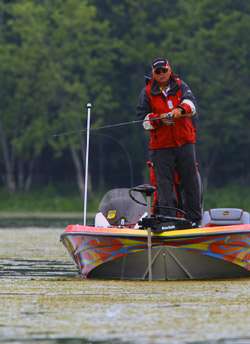
Fall is known as a time for numbers bassin'. The fish are concentrated into schools, making for easy picking at times. Problem is, most of the schooling fish are small. Elite Series pros Tommy Biffle and Todd Faircloth have figured out how to avoid the dinks and find the hawgs during the fall rush.
On many lakes anglers can find a bait ball creating commotion on the surface. Rest assured the bass aren't far behind. They gorge on these baitfish in preparation for the cold winter months when their metabolism slows down and they don't feed as actively. However, most of the fish that you see on the surface are the smaller, more aggressive fish. Faircloth will look for big bass in one of two places: (1) shallow cover such as matted grass and isolated wood and (2) in the vicinity of the bait ball.
Longtime BASS standout Tommy Biffle looks in creeks off the main lake for his fall bass. He starts at the mouth then slowly works to the back end, looking for signs of shad on the way.
"Depending on what part of fall you're in, the shad may be just outside the creeks or all the way in the back, but they'll probably be in there somewhere, and you can be sure the bass have followed," the Oklahoma pro says. "Since they're eating mainly shad, your bait should closely imitate them."
Biffle will use one of two baits when targeting big fish in creeks: a 5-inch Gene Larew Silver Craw pegged to a 5/16-ounce weight with a Tru-Tungsten Smart Peg or a white 3/8-ounce Lunker Lure jig tipped with a silver Gene Larew craw. Silver is his color of choice as it best imitates a shad.
"Depending on the density of the cover, I'll use either of these baits. If it's really thick, I'll go with the jig-and-pig; otherwise, it's the pegged craw," Biffle says. "The bigger 5-inch craw will get you the bigger bites."
Biffle uses his usual flipping tackle which consists of a Quantum Tommy Biffle Signature Series flipping stick, which as he says, "has more backbone than your typical flipping stick" to get control quickly of a fish in heavy cover. A 7.2:1 Quantum Tour Edition reel spooled with 25-pound-test Sunline fluorocarbon completes the combo. Biffle likes it to get control of a fish in thick brush quickly.
When working either the jig or the craw, the sole determining factor in deciding which bait he uses is the amount and thickness of cover. Biffle will flip the bait to the bank parallel to the laydown or past the stump, drag the bait slowly into the water, crawl it over and through the cover until he reaches open water then swims it back to the boat.
Todd Faircloth has a different approach.
As counterintuitive as it sounds, when you're after keeper-size fish and you see bass busting shad on the surface, you'll want to get the bait under the commotion without getting bit, which can be a problem, Texas pro Todd Faircloth says.
"When they're really aggressive, your bait needs to be either too big or too quick for the smaller fish. That is where the swimbaits come in."
When Faircloth finds himself in this scenario, he reaches for his 5- or 6 1/2 -inch Sebile Magic Swimmer in any of the shad colors.
"This thing is awesome. It weighs a lot, so you can cast it a mile and not spook the school," he says. "I'll toss it past the feeding activity, let it sink for a few second until it's under the school, then start slowly retrieving it."
He will start fishing his Swimmer with a steady retrieve and, if he does not get bit, he will employ a reel-jerk-pause retrieve. Faircloth prefers a hard swimbait like the Magic Swimmer because he says you can do more with it in terms of retrieve style, and it is more durable than the soft plastic one. Faircloth will throw it on a 7-foot Castaway medium-action rod with 17-pound-test fluorocarbon.
"When the fish are busting on the surface, it usually doesn't last too long, so you need to be able to reach down and get that thing in action immediately without having to mess around with it to make sure everything is straight," he says. "The quicker you can get that swimbait in there, the better off you'll be. They are a little more expensive up front, but in the end you'll come out ahead because it won't get torn up like the plastic ones."
Fall bassin' doesn't have to be all about lots of small fish!




